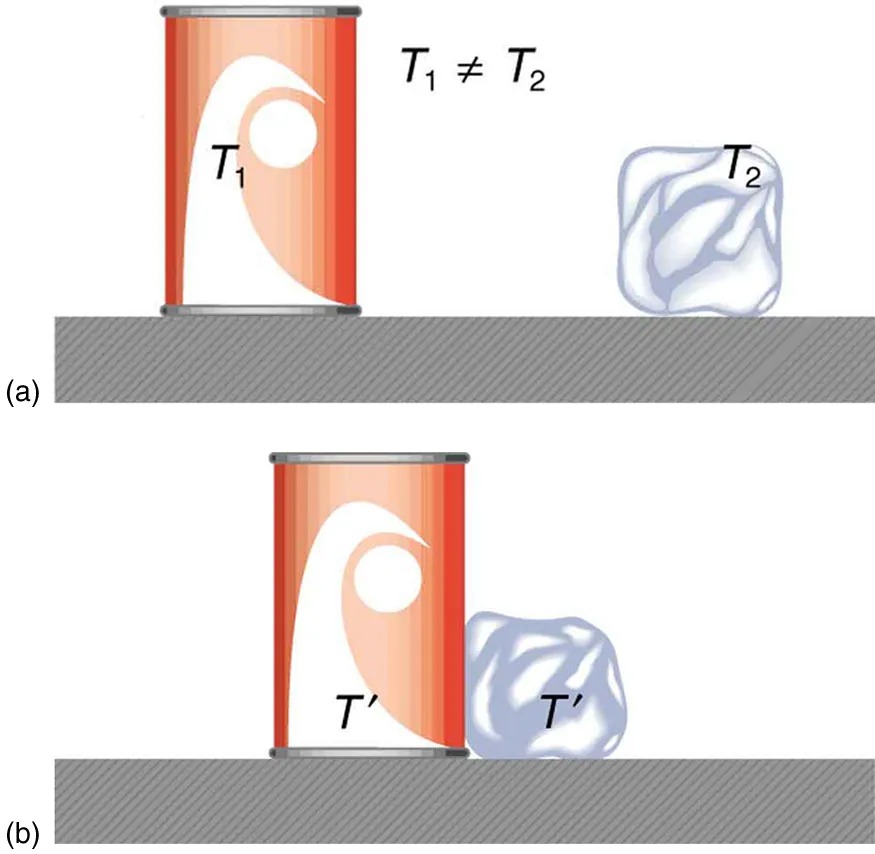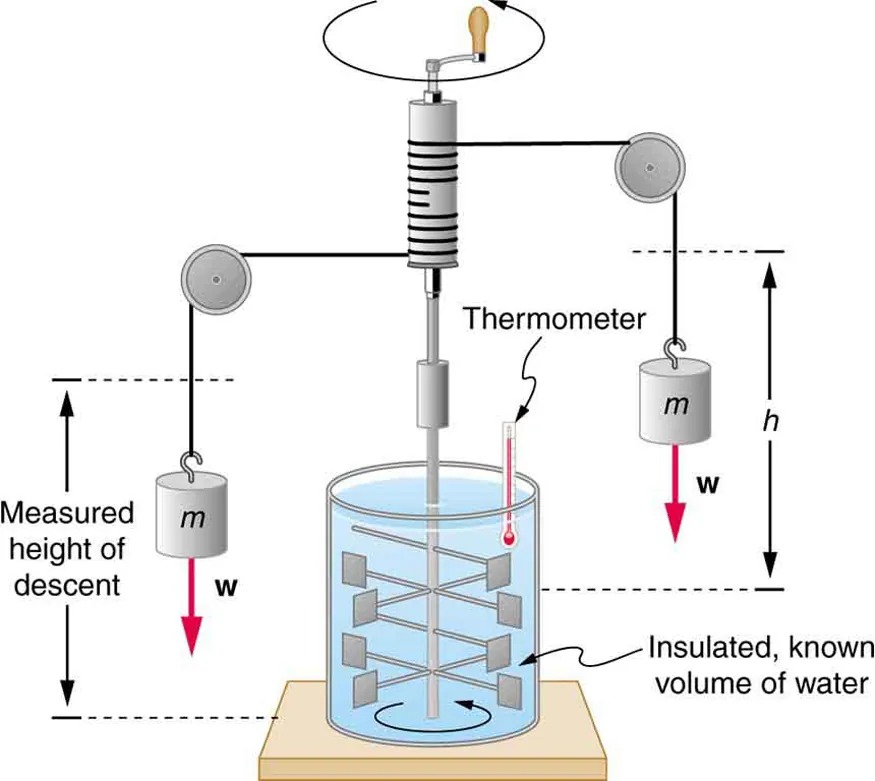12.1 Heat
Learning Objectives
By the end of this section, you will be able to:
- Define heat as transfer of energy.
In Work, Energy, and Energy Resources, we defined work as force times distance and learned that work done on an object changes its kinetic energy. We also saw in Temperature and Thermal Expansion that temperature is proportional to the (average) kinetic energy of atoms and molecules. We say that a thermal system has a certain internal energy: its internal energy is higher if the temperature is higher. If two objects at different temperatures are brought in contact with each other, energy is transferred from the hotter to the colder object until equilibrium is reached and the bodies reach thermal equilibrium (i.e., they are at the same temperature). No work is done by either object, because no force acts through a distance. The transfer of energy is caused by the temperature difference, and ceases once the temperatures are equal. These observations lead to the following definition of heat: Heat is the spontaneous transfer of energy due to a temperature difference.
As noted in Temperature and Thermal Expansion, heat is often confused with temperature. For example, we may say the heat was unbearable, when we actually mean that the temperature was high. Heat is a form of energy, whereas temperature is not. The misconception arises because we are sensitive to the flow of heat, rather than the temperature.
Owing to the fact that heat is a form of energy, it has the SI unit of joule (J). The calorie (cal) is a common unit of energy, defined as the energy needed to change the temperature of 1.00 g of water by [latex]1 .\text{00}º\text{C}[/latex] —specifically, between [latex]\text{14} . 5ºC[/latex] and [latex]\text{15} . 5ºC[/latex], since there is a slight temperature dependence. Perhaps the most common unit of heat is the kilocalorie (kcal), which is the energy needed to change the temperature of 1.00 kg of water by [latex]1 . \text{00}º\text{C}[/latex]. Since mass is most often specified in kilograms, kilocalorie is commonly used. Food calories (given the notation Cal, and sometimes called “big calorie”) are actually kilocalories ([latex]1 \text{kilocalorie} = \text{1000 calories}[/latex]), a fact not easily determined from package labeling.

Figure 12.2 In figure (a) the soft drink and the ice have different temperatures, [latex]T_{1}[/latex] and [latex]T_{2}[/latex], and are not in thermal equilibrium. In figure (b), when the soft drink and ice are allowed to interact, energy is transferred until they reach the same temperature [latex]T '[/latex], achieving equilibrium. Heat transfer occurs due to the difference in temperatures. In fact, since the soft drink and ice are both in contact with the surrounding air and bench, the equilibrium temperature will be the same for both. Image from OpenStax College Physics 2e, CC-BY 4.0
Image Description
The image is divided into two parts, labeled (a) and (b), illustrating a thermodynamic concept involving temperature.
Section (a): The illustration shows a red cylindrical container on a flat surface with a stylized design and labeled with T1. To the right of the container, there is an irregularly shaped ice block labeled T2. Above the ice block, the text T1 ≠ T2 is present, indicating that the temperatures are different.
Section (b): This part shows a similar red cylindrical container with a design and labeled with T’. It is directly adjacent to an irregularly shaped blue ice block labeled T’, both in contact on the flat surface. The illustration suggests thermal equilibrium as they share the same label.
Mechanical Equivalent of Heat
It is also possible to change the temperature of a substance by doing work. Work can transfer energy into or out of a system. This realization helped establish the fact that heat is a form of energy. James Prescott Joule (1818–1889) performed many experiments to establish the mechanical equivalent of heat—the work needed to produce the same effects as heat transfer. In terms of the units used for these two terms, the best modern value for this equivalence is
[latex]1.000 \text{kcal} = 4186 \text{J}.[/latex]
We consider this equation as the conversion between two different units of energy, defining the 15 °C calorie. A slightly different but frequently seen conversion, 4184 J/kcal, uses the properties of water at 1 °C instead. This is known as the thermochemical calorie.

Figure 12.3 Schematic depiction of Joule’s experiment that established the equivalence of heat and work. Image from OpenStax College Physics 2e, CC-BY 4.0
Image Description
The image shows a schematic diagram of a mechanical apparatus used to demonstrate the conversion of mechanical energy to thermal energy, often known as Joule’s experiment. The apparatus includes:
– A hand crank at the top used to rotate a mechanism.
– A vertical gear system with horizontal and vertical components extending from the hand crank.
– Two weights, labeled “m” for mass, hanging from each side of the apparatus by ropes. These are connected to pulleys. The weights represent forces acting downwards with arrows marked “w.”
– The left weight shows a measured height of descent, indicating how far it falls.
– In the center, a cylindrical container is filled with an insulated, known volume of water.
– Inside the water container, a series of paddles are connected to a vertical rod attached to the gear system.
– A thermometer is also submerged in the water to measure temperature changes during the process.
The function of the apparatus is to convert the potential energy of the descending weights into kinetic energy, which in turn stirs the water to increase its temperature.
The figure above shows one of Joule’s most famous experimental setups for demonstrating the mechanical equivalent of heat. It demonstrated that work and heat can produce the same effects, and helped establish the principle of conservation of energy. Gravitational potential energy (PE) (work done by the gravitational force) is converted into kinetic energy (KE), and then randomized by viscosity and turbulence into increased average kinetic energy of atoms and molecules in the system, producing a temperature increase. His contributions to the field of thermodynamics were so significant that the SI unit of energy was named after him.
Heat added or removed from a system changes its internal energy and thus its temperature. Such a temperature increase is observed while cooking. However, adding heat does not necessarily increase the temperature. An example is melting of ice; that is, when a substance changes from one phase to another. Work done on the system or by the system can also change the internal energy of the system. Joule demonstrated that the temperature of a system can be increased by stirring. If an ice cube is rubbed against a rough surface, work is done by the frictional force. A system has a well-defined internal energy, but we cannot say that it has a certain “heat content” or “work content”. We use the phrase “heat transfer” to emphasize its nature.
Check Your Understanding
Two samples (A and B) of the same substance are kept in a lab. Someone adds 10 kilojoules (kJ) of heat to one sample, while 10 kJ of work is done on the other sample. How can you tell to which sample the heat was added?
Click for Solution
Solution
Heat and work both change the internal energy of the substance. However, the properties of the sample only depend on the internal energy so that it is impossible to tell whether heat was added to sample A or B.

